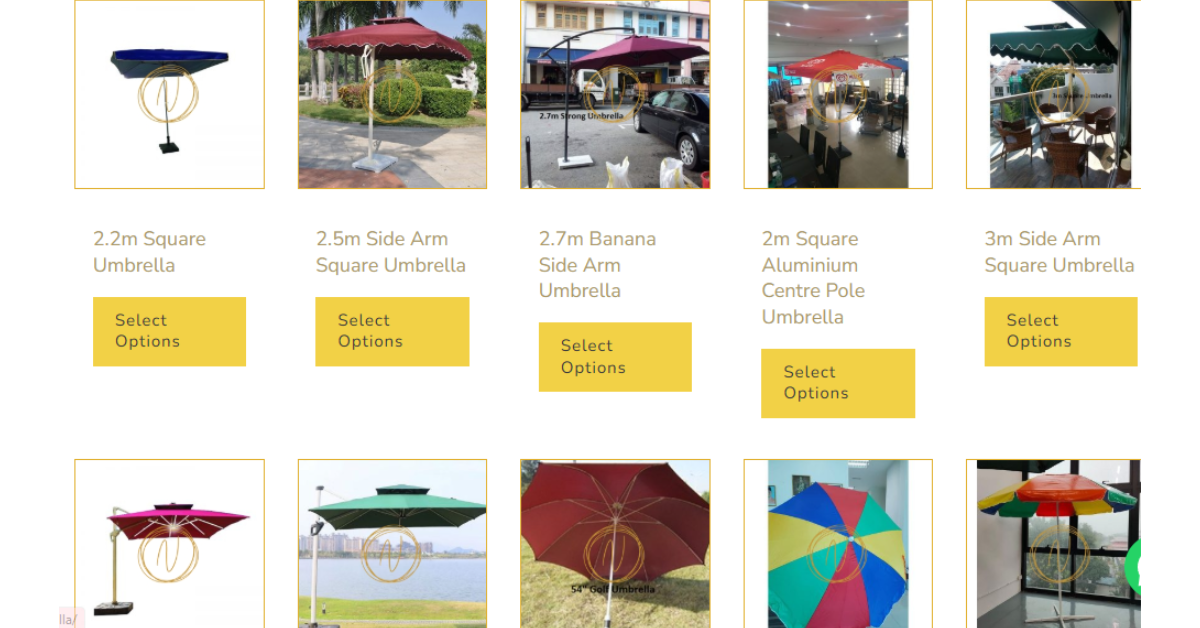Parasol Umbrella: Elegant Outdoor Shade Solutions for Every Space
Outdoor comfort and aesthetic appeal often go hand-in-hand when it comes to designing commercial or personal outdoor areas. One of the most effective and stylish ways to provide shade and shelter in these spaces is with a Parasol Umbrella. Widely used across hotels, restaurants, outdoor events, and private patios, parasol umbrellas combine form and function. In Singapore’s tropical climate, where both sun and rain are constants, the parasol umbrella is more than just a luxury—it is a necessity. This article explores the benefits, types, uses, and selection tips for parasol umbrellas, and how they can transform any outdoor environment.
What is a Parasol Umbrella?
A parasol umbrella is a freestanding canopy supported by a pole and used to provide shade from sunlight. It is commonly placed over outdoor furniture like dining tables, lounge sets, and poolside recliners. Unlike smaller personal umbrellas, parasol umbrellas are designed to cover larger areas and withstand varying weather conditions. Modern parasol umbrellas are made with UV-resistant fabrics, water-repellent materials, and durable aluminum or steel frames. Some models are equipped with tilting mechanisms, adjustable heights, and wind-vented canopies for enhanced durability and flexibility.
Types of Parasol Umbrellas
Choosing the right parasol umbrella starts with understanding the different types available in the market. Each type serves specific needs depending on usage and space layout.
1. Center Pole Parasol
This is the classic design where the pole is located at the center of the umbrella. It is ideal for dining sets with a built-in umbrella hole or where symmetrical coverage is desired. These are commonly found in cafes, patios, and garden settings.
2. Cantilever (Offset) Parasol
In this design, the pole is offset to the side, and the canopy is suspended from above. This allows for unobstructed space beneath the umbrella, making it perfect for lounge areas, poolside setups, and dining tables without center holes. Cantilever umbrellas offer better maneuverability and a modern aesthetic.
3. Wall-Mounted Parasol
Ideal for small spaces like balconies and terraces, wall-mounted parasols are attached directly to a wall and can be folded when not in use. This design saves floor space and is great for residential use or narrow commercial walkways.
4. Commercial-Grade Parasol
Built with heavy-duty materials and larger canopies, commercial parasols are designed for high-traffic environments like hotel courtyards, resorts, and event venues. They often include enhanced stability features and are engineered to withstand prolonged exposure to sun, wind, and rain.
Benefits of Using Parasol Umbrellas
Parasol umbrellas offer a wide range of benefits beyond just shade. Whether for residential or commercial use, they elevate comfort, functionality, and design.
Protection from UV Rays
High-quality parasol umbrellas are made with UV-resistant fabrics that block harmful ultraviolet rays, protecting users from sunburn and long-term skin damage.
Enhanced Outdoor Comfort
By reducing glare and heat, parasol umbrellas create a more comfortable space for dining, relaxing, or socializing outdoors—even during the hottest part of the day.
All-Weather Utility
Many parasol umbrellas are water-repellent and wind-resistant, offering reliable shelter during unexpected rain or wind gusts. Some models also come with wind vents and tilt adjustments for added resilience.
Aesthetic Appeal
Available in various colors, shapes, and materials, parasol umbrellas can complement any architectural or landscaping theme. They add elegance and structure to open areas, turning plain spaces into inviting venues.
Portability and Flexibility
Unlike permanent shade structures, parasol umbrellas can be moved, adjusted, or replaced easily. This makes them ideal for both temporary setups and evolving layout needs.
Common Uses of Parasol Umbrellas in Singapore
Parasol umbrellas are widely used across Singapore in various settings where both function and design matter. Here are some common applications.
Outdoor Dining Areas
Cafés, restaurants, and bistros often use parasol umbrellas to shade diners in alfresco settings. They create a cozy, sun-protected environment that enhances the customer experience.
Hotel and Resort Spaces
Luxury properties use large parasols to offer poolside comfort, beach lounging, or shaded relaxation decks. These umbrellas contribute to the overall guest experience and brand image.
Events and Exhibitions
Parasol umbrellas are commonly seen at outdoor events, fairs, and weddings, providing shade for registration booths, VIP areas, and refreshment zones.
Retail and Display Setups
Temporary stalls, outdoor markets, and lifestyle fairs use parasols to shield products and staff from the elements while drawing attention to their stalls.
Residential Outdoor Spaces
Homeowners use parasol umbrellas for patios, balconies, gardens, and rooftops to create relaxing spots for reading, dining, or entertaining guests.
Choosing the Right Parasol Umbrella
Selecting a parasol umbrella involves more than just picking a color. Here are the key factors to consider.
Size and Coverage Area
Choose a size that adequately covers your intended space. A small 2.5-meter umbrella may be suitable for a balcony, while a 4-meter cantilever umbrella may be better for a poolside area or large table.
Material and Fabric
Opt for weather-resistant materials. Polyester is affordable, while acrylic and olefin fabrics offer better UV protection and colorfastness. Frames made from powder-coated aluminum or galvanized steel are durable and rust-resistant.
Base and Stability
A sturdy base is essential to prevent tipping. Some bases are fillable with water or sand, while others come with mounting options. Ensure the base weight matches the umbrella’s size.
Functionality and Features
Look for features like tilt mechanisms, crank lifts, or rotation functions to improve usability. Wind vents are also useful in Singapore’s climate to allow air flow and reduce uplift during breezy conditions.
Branding and Customization
For commercial use, consider parasols that allow for logo printing or custom colors. Branded parasol umbrellas enhance visibility and reinforce brand identity.
Maintenance Tips for Longevity
Parasol umbrellas are an investment. Proper maintenance ensures they last longer and remain visually appealing.
-
Close the umbrella when not in use, especially during strong wind or heavy rain
-
Clean the canopy fabric regularly with mild soap and water
-
Store the umbrella in a dry place or use a cover when not in use for extended periods
-
Inspect the joints and frame regularly for wear or rust, and apply protective coatings if needed
Why Parasol Umbrellas are Ideal for Singapore’s Climate
Singapore’s hot and humid climate with frequent rainstorms makes parasol umbrellas a highly practical solution for any outdoor setting. With their ability to provide immediate shade and shelter, they are especially valuable in outdoor commercial areas where customer comfort is key. Businesses that invest in quality parasol umbrellas often find increased customer satisfaction, longer visitor stays, and a more polished brand presentation.
Parasol Umbrella Rentals for Events
Not every occasion calls for a permanent purchase. For short-term needs like weddings, product launches, or pop-up markets, parasol umbrella rentals are a smart alternative. Event logistics providers in Singapore, like NexGlobal, offer turnkey solutions that include umbrella rental, delivery, installation, and dismantling. Renting is cost-effective and ideal for one-time or seasonal events.
Frequently Asked Questions (FAQs)
1. What size parasol umbrella should I choose?
The size depends on your intended coverage area. A 2.5m diameter umbrella typically covers a 4-seater table, while 3–4m umbrellas suit larger seating arrangements or lounge zones.
2. Are parasol umbrellas waterproof?
Most quality parasol umbrellas are water-resistant, not fully waterproof. They can handle light to moderate rain but may not be ideal in stormy conditions unless designed specifically for such use.
3. Can I use a parasol umbrella in windy conditions?
It depends on the umbrella’s build. Look for models with wind vents and heavy bases. In very strong wind, it’s always best to close and secure the umbrella.
4. Is it better to buy or rent a parasol umbrella?
For permanent installations, purchasing is the best choice. For one-off events or seasonal use, renting from a logistics provider like NexGlobal offers convenience and cost-efficiency.
5. Can parasol umbrellas be branded?
Yes, many suppliers offer customization options including logo printing and color matching for commercial use, especially useful for restaurants and retail displays.
Conclusion
A parasol umbrella is more than just a shade solution—it’s a strategic investment in comfort, aesthetics, and functionality. Whether you are furnishing a rooftop bar, equipping a beachfront resort, or planning a weekend event in Singapore’s unpredictable climate, parasol umbrellas offer dependable shelter and a polished look. With a range of designs, materials, and customization options, these umbrellas cater to both personal and commercial needs. Companies like NexGlobal offer both sales and rentals, making it easier than ever to add this elegant utility to any outdoor space. Choose wisely, maintain regularly, and enjoy the benefits of elevated outdoor comfort.
Read More







